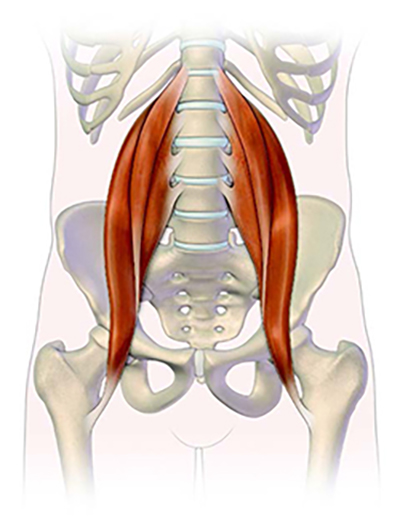(Aether Bios Clinic) Bridgeford’s Best Bites: Osteopathy Tips
PSOAS MUSCLES

Pronounced ‘SOAS’ and together with related ‘sister’ muscle the ilacus, also called the iliopsoas. They are major hip flexors and connectors between the torso and the legs, affecting posture and spinal stability while sitting and in movement. They consist of both fast and slow twitch muscles fibres and are involved in all types of movement from active sports and dance to sitting in the chair or lounging around. They move the legs towards the torso when the torso is fixed (leg lifts, walking up stairs, running) and the torso towards the legs when the legs are fixed (sit-ups). They flex the trunk to bend forwards and pick something up. Imbalance in the psoas muscles can create overcompensation in other muscles and cause low back, pelvic and groin pain.
Anatomy: They are the deepest core muscles, about 16 inches long and the only muscles that connect the spine and the legs. They attach to either side of the spine at the front on the transverse processes of the 12th thoracic vertebra, 5 lumbar vertebrae and intervertebral discs, passing through the pelvis to attach to the medial lesser trochanter of the femur. Their nerve supply is from lumbar 1-3. They attach to the spine next to the crurae, the tendons of the diaphragm, with the medial arcuate ligaments wrapping around the top of each psoas muscle. They provide support for the internal organs and their movement with the diaphragm encourages fluid flow. There are deep fascial connections between the psoas, diaphragm, other hip muscles, the pelvic organs and the spine. The diaphragm basically attaches directly or indirectly to all organs.
Breath and Emotions: Psoas connections to the diaphragm, connects them to the breath and emotions. When we are startled or stressed (fight, flight or freeze) we hold our breath, the diaphragm contracts and so does psoas. Continued stress causes continued contracted psoas, contributing to low back pain. During later pregnancy, pressure on the diaphragm can cause breathlessness; due to the psoas diaphragm connection, releasing psoas can help to ease the breathing. Balanced psoas function is important in the birth process, encouraging a smoother 2nd stage.
Symptoms: You may have a leg length difference, rotated pelvis, knee and back pain, postural problems; there may be an impact on organs, affecting bowel movements, menstrual cramps, difficulty to breathe fully and feeling exhausted. Tight of the psoas can result in spasms in the back or lower back pain by compressing the discs. Hypertonic, inflamed psoas can irritate and entrap the iliolingual and iliohypogastric nerves that branch off 1st lumbar nerve, causing a sensation of heat or water running down the front of the thigh. With both psoas muscles tight, the lower back will tend to arch back in a lordosis; tightness on one side will cause a lean to the side of the tightness, often causing symptoms of sciatica into the butt and down the leg. A typical result of psoas tightness or spasm is that you lean forward and get stuck and also find it difficult to get up straight, particularly first thing in the morning. As a deep core muscle, imbalance in one or both psoas muscles can affect our ability to activate our core strength properly and thus have an impact on any incontinence issues.
Causes: Many situations can cause the psoas muscles to contract: long periods of stress, sitting for a long time, excessive exercise, including walking and running, a lot of sit ups, sleeping in the foetal position, prolonged bad posture, injury, laying in bed too long with an existing back problem. Awkward movements involving heavy or repeated lifting and also twisting, such as digging, moving heavy, awkward objects, etc. Dehydration can impact the psoas muscles due to their physical connection with the kidneys as well as the overall impact on muscles. The demands of a changing body during pregnancy can affect the psoas muscles and it is important to keep them balanced to aid a smooth delivery as possible.
Diagnosis: Psoas problems are often misdiagnosed as they can present with symptoms of sciatica and disc problems. If your symptoms are severe enough to take you to the doctor or hospital, you may have X-rays, MRI and neurological examinations and even though your pain is real, things can appear ‘normal’.
Osteopathic/Manual Management: Osteopathic diagnosis includes neurological, orthopaedic and movement testing as well as a detailed case history to determine possible cause. Using muscle testing, where appropriate and palpation to ‘listen’ to the body with ‘thinking feeling fingers’ to determine the cause and extent of the problem and best course of treatment for the individual. Treatment may include stretching, deep soft tissue work, myofascial techniques, adjusting/manipulation, dry needling, home rehabilitation exercises; attention to postural habits, appropriate exercise and ergonomics. Stress aspects will be considered both physically, biochemically and with various relaxation and breathing exercises where appropriate.
We are happy to advise you on your health matters.
Lin Bridgeford DO KFRP MICAK MICRA FSCCO MSc
Registered Osteopath & Kinesiologist & Yoga Teacher
Aether Bios Clinic
Saltdean
01273 309557 07710 227038
